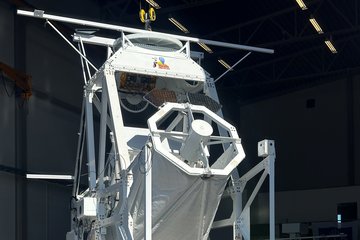All genres
301.
Talk
Rossby waves on the Sun. 15th European Solar Physics Meeting, Budapest, Hungary (2017)
302.
Talk
Multiple scattering of acoustic waves. Rocks \& Stars II, Göttingen, Germany (2017)
303.
Talk
On the analysis of large data sets in the PLATO Data Center. Annual Meeting of the German Astronomical Society, Bochum, Germany (2016)
304.
Talk
Measurements of solar convective flows in the near-surface layers. Dynamic Sun I conference, Varanasi, India (2016)
305.
Talk
SpaceInn local helioseismology. Joint TASC2 \& KASC9 Workshop - SPACEINN \& HELAS8 Conference, Angra do Heroísmo, Portugal (2016)
306.
Talk
Kinetic helicity and anisotropic stresses of solar supergranulation. Workshop on Turbulence and Waves in Flows Dominated by Rotation: Lessons from Geophysics and Perspectives in Space Physics and Astrophysics, Boulder, Colorado, USA (2016)
307.
Talk
Supergranulation, Revisited. Observing the Sun conference, Santa Cruz, USA (2016)
308.
Talk
Helioseismology and the solar interior. 5th SOLARNET Summer School, Belfast, UK (2016)
309.
Talk
Probing convection with SDO helioseismology. Munich Joint Astronomy Colloquium, Garching, Germany (2016)
310.
Talk
Modelling solar oscillations. Colloque Interfaces, INRIA Bordeaux, France (2016)
311.
Talk
Dynamics of solar supergranulation. 17th MHD Days, Göttingen, Germany (2016)
312.
Talk
Evolution of solar intermediate-scale convection. Seismology of the Sun and Distant Stars (HELAS8/SPACEINN/TASC2/KASC9), Angra do Heroismo, Portugal (2016)
313.
Talk
Accurate numerical solutions to the forward problem of local helioseismology. Seismology of the Sun and the Distant Stars 2016, Angra do Heroísmo, Portugal (2016)
314.
Talk
Solar Cycle Dependence of the Deep Meridional flow. Joint TASC2 \& KASC9 Workshop -- SPACEINN \& HELAS8 Conference, Angra do Heroísmo, Portugal (2016)
315.
Talk
Measuring active region inflows with local correlation tracking. Solar and Stellar Magnetic Fields - a conference in honor of Manfred Schuessler, Goslar, Germany (2016)
316.
Talk
Parameter identification for the acoustic wave equation in helioseismology. The 12th International Conference on Mathematical and Numerical Aspects of Wave Propagation , Karlsruhe, Germany (2015)
317.
Talk
Seismic diagnostics of rotation and magnetic activity. 2nd SOLARNET Meeting: Solar and stellar magnetic activity, Palermo, Italy (2015)
318.
Talk
Perspectives in Helioseismology. NASA LWS Workshop on Solar Dynamo Frontiers: Helioseismology, 3D Modeling, and Data Assimilation, National Center for Atmospheric Research, Boulder, Colorado, USA (2015)
319.
Talk
Seismology of the Sun. Greifswalder Physikalisches Kolloquium, Greifswald, Germany (2015)
320.
Talk
Seismology of the Sun and Stars. MPG Heads of Partner Group Meeting 2015, Chennai, India (2015)










